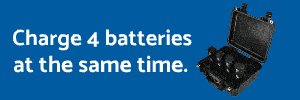A fellow instrument rated, and 107 pilot, Steve Rhode working for Wake Forest Fire Dept., NC gave me a green light to post one of his newsletter articles.
I just put the brakes on a Matrice 210 combo/FLIR/Z30 purchase until DJI gets it right.
Scariest Matrice Flight of My Life, So Far
The problem with the DJI TB50 and TB55 batteries is ongoing despite a firmware update. In fact, even with the update I have grounded our Matrice until further notice. Everyone has to make their own judgment but in my opinion the risk of injury to people and damage to the aircraft is too high for continued operations at this point. This problem is impacting Matrice 200 series and Inspire 2 aircraft.
On a mission flight the other night the problems really raised their ugly head. Even though I had installed all DJI updates and flight tested the aircraft with a set to TB55 batteries to exhaustion at 6" above the ground without any error, it did not show the overall problem.
In this post I present a video showing the problem in flight and the dangerous and inconsistent symptoms. See DJI Battery Issues Create Extremely Dangerous Flight Experience
Here is some candid advice I gave to a good pilot friend. “The firmware problem is consistently inconsistent and that is where the big issue is.
Unfortunately I just flat out grounded myself until the problem is resolved. You can imagine being out on a search and rescue or inspection and all of a sudden the Automatic Landing (AL) kicks in. There is no way to stop it. The aircraft is going down.
Since publishing that post I've heard from others who are experiencing the same issue. I've also heard from folks who are flying anyways. [Note: Each pilot and department has to make the decision for themselves since we do not have an agency in the United States that can order you to ground your aircraft.]
You can imagine the insane risk I would have faced if I had flown the 210 out further, even over a buildings, on the [redacted] and the thing AL near [redacted]. In fact at one point the EOC asked me to get closer and I said no. It was one of those moments when the role and responsibilities of the pilot have to override command requests.
I flew to what I considered the limit of safety and minimized damage that might occur if the aircraft had a flight failure. I elevated my risk by continuing to fly once I had run into the AL issue given the information it was generating was being used and important. But once the flight was over that was it.
While the video shows the dreaded AL problem, it does not show the other RTH error message that seems to randomly appear. Those you can cancel and continue flight.
If you'd like to be added to his newsletter/email list. [email protected].
I just put the brakes on a Matrice 210 combo/FLIR/Z30 purchase until DJI gets it right.
Scariest Matrice Flight of My Life, So Far
The problem with the DJI TB50 and TB55 batteries is ongoing despite a firmware update. In fact, even with the update I have grounded our Matrice until further notice. Everyone has to make their own judgment but in my opinion the risk of injury to people and damage to the aircraft is too high for continued operations at this point. This problem is impacting Matrice 200 series and Inspire 2 aircraft.
On a mission flight the other night the problems really raised their ugly head. Even though I had installed all DJI updates and flight tested the aircraft with a set to TB55 batteries to exhaustion at 6" above the ground without any error, it did not show the overall problem.
In this post I present a video showing the problem in flight and the dangerous and inconsistent symptoms. See DJI Battery Issues Create Extremely Dangerous Flight Experience
Here is some candid advice I gave to a good pilot friend. “The firmware problem is consistently inconsistent and that is where the big issue is.
Unfortunately I just flat out grounded myself until the problem is resolved. You can imagine being out on a search and rescue or inspection and all of a sudden the Automatic Landing (AL) kicks in. There is no way to stop it. The aircraft is going down.
Since publishing that post I've heard from others who are experiencing the same issue. I've also heard from folks who are flying anyways. [Note: Each pilot and department has to make the decision for themselves since we do not have an agency in the United States that can order you to ground your aircraft.]
You can imagine the insane risk I would have faced if I had flown the 210 out further, even over a buildings, on the [redacted] and the thing AL near [redacted]. In fact at one point the EOC asked me to get closer and I said no. It was one of those moments when the role and responsibilities of the pilot have to override command requests.
I flew to what I considered the limit of safety and minimized damage that might occur if the aircraft had a flight failure. I elevated my risk by continuing to fly once I had run into the AL issue given the information it was generating was being used and important. But once the flight was over that was it.
While the video shows the dreaded AL problem, it does not show the other RTH error message that seems to randomly appear. Those you can cancel and continue flight.
If you'd like to be added to his newsletter/email list. [email protected].






